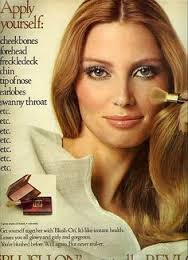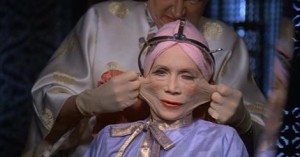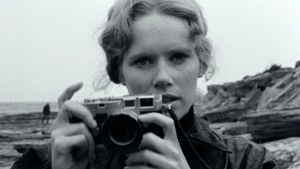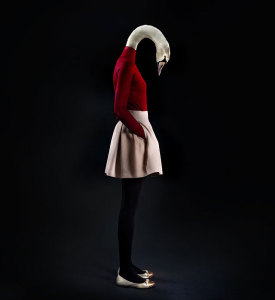LET US LEAVE pretty women to men with no imagination. Proust was the one who said that. And apparently he was gay, which means he may have had a clearer view of women than most straight men would have, less clouded by desire. He probably won a lot of female admirers when he wrote that. Finally, some room to breathe; a world beyond pretty. But there is no denying that pretty opens doors. Pretty hushes a room, and slows traffic, and gets slightly better deals on pre-owned vehicles. Pretty causes spontaneous surges in dopamine. But pretty changes over time, like everything.
When we were kids my sister and I sometimes played a game we made up called Hopeless Cases. We would each draw a picture of a girl’s face and body and make them as homely and unattractive as possible. Certain features and flaws would be exaggerated comically, and just so no one missed important details, we’d label them with arrows and quick descriptions around the periphery of the drawing: “Huge pimple.” “Big Nose.” “Knobby Knees.” “Crooked Teeth.” “Stringy Hair.” Then we’d decide who had drawn the best, most hopeless case.
Two girls sprawled on a sagging velvet couch, bent over their spiral-bound notebooks in serious concentration, searching for imperfections. I’ve thought about this over the years and it’s become stranger and stranger to me that we did this. What I probably only knew subconsciously at the time is that we were drawing ourselves, even if the features often didn’t match our own. We weren’t making fun of other girls. We were trying to come up with the worst, most extreme version of ourselves so that we’d get it all out of our systems right then and there. If we could insult ourselves then maybe we’d somehow be protected from the judgment of others. We took what we feared were our flaws and put them front and center. We were just kids and we were beautiful, the way all kids are beautiful, but we were already drinking the Kool Aid seeping out of the television and magazines and the unhappiness of others around us.
One of those inspirational Dove soap ads reminded me of our old game when it popped up on a Youtube video. The latest in Dove’s self-esteem-boosting campaign features women talking about the things they don’t like about their appearance, then shows their young daughters answering the same question about their own appearance. Without knowing what their mothers had said, the girls (at least in the selection featured in the ad) answered similarly to their mothers. Meaning they had picked up on their mothers’ insecurities and made them their own. Overall message: use Dove products. Message under that one: be careful what you say around your kid. Message under that one: try not to hate yourself so much.
Dove products will not stop time. There was a lot of chatter about cosmetic surgery recently, when one particular actress got a face overhaul. She took a beating for it; the reaction was unseemly. When you’re under that kind of scrutiny, you will not win. But I just kept thinking this: When someone pays a plastic surgeon to muck around with their face, it’s as though they’re re-routing a stream, so that all the natural patterns in the water and the rocks get disrupted. If a face is a story, then plastic surgery is an attempt to alter the story midway through.
The actress Liv Ullmann once commented: “I think it is sad that more women don’t take the chance that maybe men will be moved by seeing the chin a little less firm than it used to be, that a man will be more in love with his wife because he remembers who she was and sees who she is and thinks, God, isn’t that lovely that this happened to her. And be moved by life telling its story there.” It’s no wonder some women are scared of letting time do its thing—the culture at large has a fairly deadly response, and there are certainly men out there who don’t think isn’t that lovely that this happened to her. But in theory Ullmann makes a very good point. Risk it and see who sticks around.
Actress Charlotte Rampling, another legendary beauty, is the subject of a documentary called Charlotte Rampling: The Look, from 2011. It shows Rampling in conversation with artist friends of various kinds—writers, photographers, etc. For much of the film we’re watching Rampling, now with the face of an older woman, talking about desire, projection, love, and taboos. At one point she sits with photographer Peter Lindbergh at a table, looking at photographs of her younger self, commenting on her appearance. She jokes that her famously heavy-lidded eyes are becoming so heavy they’re nearly closed. They touch on the subject of facelifts—something she has clearly not had herself—and she says, without a tone of judgment but simply as an observation: “The thing is…when you change faces, they’re all changed in the same sort of way.”
There are clips from her early movies throughout the film. In every one, her face is stunning, a vortex of ravishing. Now her face is fascinating in a different way. Her eyes always looked somewhat melancholy but now they are more so. Her mouth purses in a more severe way, curving downward. Her smile is brilliant—a reflection of decades of joys and sorrows. She is herself, trying to be honest, someone who’s deepening into life. Should I call it brave of her to simply sit in front of a camera, now with the face of an older woman, talking about important things? It’s not death-defying bravery but it’s bravery of a sort, since even a gorgeous actress, if she’s older, will attract a critical eye. Her face forces us to see things we don’t want to see. We tend to be obsessed with people’s surfaces, especially the surfaces of women, but there’s no way to reflect back everything that people think they want or need from female beauty.
I saw an unnerving photograph of a beautiful swan digitally dressed in human clothes—a cute red turtleneck and dainty white skirt, black tights and adorable flats—and it made me think of a woman who can’t get comfortable with herself, posed as she is for the admiration of others. The swan’s head is bent over in a shameful posture, as if to say, I know I’m beautiful but could you please stop looking at me now. I want to go back to my pond.
By the time we get to the later discussions in the Rampling documentary, we’ve been taken way below the surface. Rampling and her counterparts are no longer talking about images and projections. Now they’re discussing demons and aging and death. Now we’re getting to the bottom of things. This is where we’ve been heading all along.
In my mind it takes me back to this amazing moment. When my father was in the hospital, shortly before he died, I stood by the bed talking to him and at one point he shifted his gaze up to the ceiling, and when he did that his expression changed and suddenly I saw my brother’s face in his—there was my brother as an old man, there was my father as a younger man. They were just two people at different points on the continuum. My brother, healthy and strong now, was going to have a different-looking face someday. Both different and the same.
For a while there afterward, I was picturing almost everyone I knew as an old person. Chances are if I met you for coffee, or ran into you at the grocery store, I was doing it to you, trying to picture your face at a later point on the continuum. It was comforting somehow, a reminder that there is no real divide between the young and the old, just a matter of time. Even that elegant swan will look a little ragged someday. But like any human who lets the story unfold naturally, she’ll be more and more herself along the way.








Such a powerful, relatable piece!
My niece is three- nearly four- and for Hanukah this year, she’s asked for an American Girl doll Bitty Baby. These come in most skin and eye colors but she asked for a blond-haired, blue-eyed one. Which made me sad. Not even in kindergarten and already being indoctrinated into the beauty myth!
My parents bought me an American Girl doll when I was seven or eight and her name was Kirsten. Kirsten was a Swedish immigrant whose family settled in Minnesota. She had blond hair, blue eyes, and came with a red-and-white checked bonnet and apron.
I must have asked for her but, for the life of me, I can’t imagine why. Swedish immigrant? Minnesota plains? I’d hated “Little House on the Prairie” so what was I doing with this bitch?
Blond hair, blue eyes. Tiny button nose. My total opposite.
In high school, I learned to hate myself for all sorts of new things: for the bulge of my stomach and the weird fleshiness of my fingers. For the numbers on the scale that never went down fast enough.
What a waste, isn’t it?
Every year, I tell myself that this is the year that I’ll finally come to terms with my appearance. I’m too old for this shit, I think.
But I never quite seem to…
Excellent piece. Beauty is never the issue. Self-esteem is. And it should be considered as a daily fight, not as a “once for all” thing. Beautiful people kill themselves too. Beauty is only a superficial and perverse power play about norms. It is extremely difficult to accept to veer away from norms. That’s why you have to realize that it is, precisely, their purpose. To make most of us unhappy and want to conform. But, as Baudelaire once famously said: “Le Beau est toujours bizarre”. True beauty never fits. Self-esteem does. But it doesn’t care about norms. On the contrary, self-esteem is systematically against norms. Women (and men) should realize that. And start being free about their own image. And loving it. And turning it into a revolutionary thing. A beautiful thing, in itself.